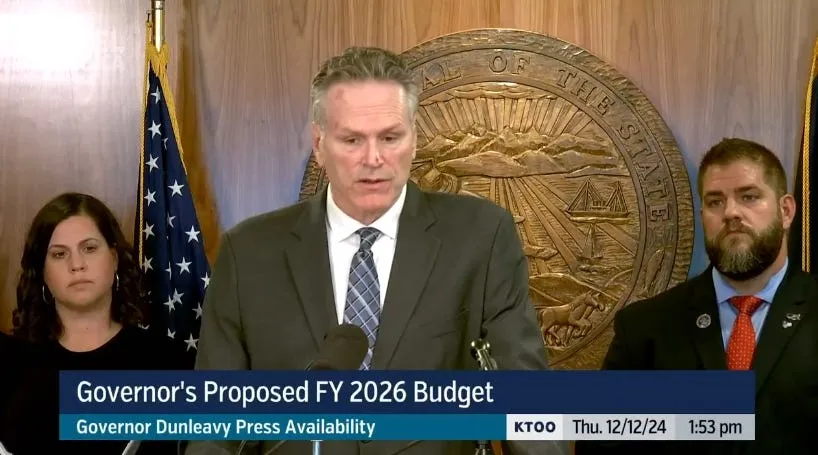Day 36: 'Benefit to society'
"I'm disturbed by this line of questioning."

Good afternoon, Alaska!
In this edition: A deeper look at Rep. David Eastman’s latesty ghastly statements where he wondered whether a child dying at the hands of an abuser is actually a “benefit to society” because dead kids don’t need state social services. While Eastman certainly went out on a ghoulish limb, this whole idea of putting a price on someone’s wellbeing isn’t exactly new for Alaska conservatives. Also, we can’t overlook that wishy-washy language.
Current mood: 😡
‘Benefit to society’

The House Judiciary Committee’s Monday hearing on childhood trauma—a look at how adverse childhood experiences can cause life-long impacts on everything from a person’s health and education to their employment later in life—took a grim and disturbing twist when Wasilla Republican Rep. David Eastman asked about an argument he claimed he’s heard before: Whether kids killed by abusers are actually a “benefit to society” because they no longer need support from state social services.
“How would you respond to the argument that I’ve heard on occasion where in the case where child abuse is fatal—it’s obviously not good for the child—but it’s actually a benefit to society because there aren’t needs for government services and whatnot over the full course of that child’s life?” said the Wasilla Republican who has long taken shots at fellow Republicans for not being anti-abortion enough in a clip that has made the rounds.
There's already been a lot said about Rep. David Eastman's line of questioning about whether a child dying is "actually a benefit to society."
— Matt Acuña Buxton (@mattbuxton) 8:34 PM ∙ Feb 21, 2023
Worth pointing out how he couches it as a "an argument I've heard on occasion." Seems like a common tactic.
#akleg
Eastman, who beat an attempt to disqualify him from serving in the Legislature over his membership in the Oath Keepers militia group, is not a member of any caucus and therefore has no guarantee to committee seats, yet the Republican-led House Majority granted him a seat on the House Judiciary Committee.
“Can you say that again?” replied Trevor Storrs, the president and CEO of the Alaska Children’s Trust, a non-profit focused on preventing child abuse and neglect. “Did you say a benefit to society?”
“Talking dollars,” Eastman elaborated, “You’ve got a $1.5 million price tag for victims of fatal child abuse. It’s argued periodically that it’s actually a cost savings because that child is not going to need any of those government services that they might otherwise be entitled to receive and need based on growing up in this type of environment.”
Eastman didn’t offer any examples of where the death of children at the hands of abusers was beneficial to the state’s bottom line, but it’s not the first time he’s made outlandish remarks in the Legislature. In 2017, Eastman became the first House member ever to be censured because of claims that women got abortions so they could get Medicaid-funded vacations to Anchorage and Seattle.
Storrs, who had spent the last hour explaining the wide-ranging impacts of childhood trauma with Dr. Jared Parrish, a state epidemiologist who specializes on child well-being, struggled to reply.
“That would be the idea, if I could use a really bad analogy, that if you hit somebody to always back up because it’s cheaper to insurance,” he said. “I don’t pertain to that, and I’m not even sure how to answer that that there’s a cost savings to the death of a child. The impact that that has on a family and us as a society when a child is lost, especially to child abuse and neglect is unmeasurable. It’s hugely tragic.”
The $1.5 million calculation is based on an individual’s expected lifetime earnings and comes from a study on the economic cost of child abuse and neglect in Alaska, which also found that the cost could grow to as much as $18 million when you factor in intangible impacts like pain and suffering surrounding the death of the child. It isn’t a price tag of the services that individual would otherwise incur, as Eastman had suggested, had they grown up.
Eastman was undaunted by Storrs’ response and continued his line of questioning, asking whether it made a difference how old the child was when they were killed. Parrish explained that the calculation was complicated but that it was based on their expected lifetime earning potential and contributions to society.
“And so would the $1.5 million price tag,” Eastman continued, “would that be different if we were talking about a six-month-old versus a newborn on day one?”
“It would be marginally different,” Parrish replied.
And here's the follow-up with more explanation about how the cost of a dead child isn't just the cost of services (which Carpenter was also on about) but their lost contributions.
— Matt Acuña Buxton (@mattbuxton) 8:34 PM ∙ Feb 21, 2023
Eastman follows up by asking if there's a difference between a dead newborn and a dead 6 month old.
The committee moved on from that particular line of questioning, but not before Anchorage Democratic Rep. Cliff Groh said he was “disturbed” by the line of questioning.
At the close of the hearing, Anchorage Democratic Rep. Andrew Gray responded more directly to the response, noting that he adopted a child who had a high adverse childhood experiences score.
“I had an intense reaction to something that was said earlier. I adopted my child through the foster system, my child came with a very high ACEs (adverse childhood experiences) score that definitely meant we had resources that needed to be expended to help my child but what I heard was, and it may not have been intended, was that there would be a cost savings if child with a high ACEs score didn’t survive,” Gray said. “I would just say that for me, personally, my child is the greatest joy I’ve ever had and there’s no price tag on that.”
Eastman, who sits next to Gray, didn’t respond to the comments. Instead, he asked Storrs if it made sense, then, to cut spending on state prisons and funnel the money toward preventing child abuse. Storrs said additional funding would be good, but said it’s not as simple as diverting money from an existing problem to preventing another.
“Unfortunately we have neglected prevention for so long that we’ve been seeing these high costs,” he said. “This won’t just disappear. It’s taken us decades to be where we are, it’s going to take a couple decades to change it.”
Money problems

While Eastman’s point about child deaths being good for the state’s bottom line was particularly head-turning, he’s not entirely alone in putting the cost of addressing and preventing child abuse at the forefront of the discussion. Nikiski Republican Rep. Ben Carpenter also had a lengthy back and forth with Storrs and Parrish about the state’s involvement in the issue, wondering whether it should really be the state’s responsibility.
“It’s not surprising that poor decisions result in poor outcomes,” he said, griping that he felt the presentation was entirely built around increasing state spending.
This content is for Paid Members
Unlock full access to The Alaska Memo and see the entire library of members-only content.
SubscribeAlready have an account? Log in



